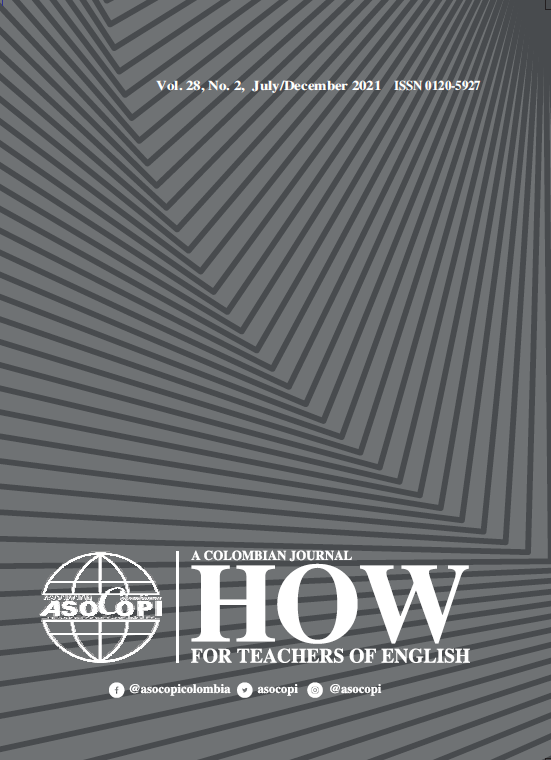Feminism in a Female Teacher’s Discourse in an EFL Classroom
Main Article Content
Abstract
This research article on feminism gives an account of the interaction between a female teacher and her students at a public university in Tunja, Colombia. The study aims to evidence features of feminism within an English as a foreign language classroom by analyzing the transcriptions of the teacher’s discourse using the Feminist Poststructuralist Discourse Analysis. As a result of the study, it can be stated that feminism is not determined by gender, but rather, it is an individual choice that is socially constructed and transmitted through power relationships. Findings suggest that being female or male does not guarantee having a definite position towards feminism; instead, it is mostly demarcated by the specific situations and circumstances that each individual experiences within a society.
Article Details

This work is licensed under a Creative Commons Attribution-NonCommercial-NoDerivatives 4.0 International License.
The authors of the manuscripts accepted for publication in HOW journal are required to sign a nonexclusive license agreement allowing ASOCOPI to reproduce the full text on the Internet or in any other available source. Authors retain copyright of their manuscripts with the following restrictions: first publication is granted to ASOCOPI; nonexclusive agreements with third parties can be established as long as the original publication in the HOW journal is properly acknowledged.
References
Bartlett, T. (2014). Analyzing power in language: A practical guide. Routledge. https://doi.org/10.4324/9781315851938
Baxter, J. A. (2003). Positioning gender in discourse: A feminist methodology. Springer. https://doi.org/10.1057/9780230501263
Baxter, J. A. (2008). Feminist post-structuralist discourse analysis: A new theoretical and methodological approach? In K. Harrington, L. Litosseliti, H. Sauntson, & J. Sunderland (Eds.), Gender and language research methodologies (pp. 243-255). Palgrave Macmillan.
Beauvoir, S. L. E. M. B. (1949). Le deuxieme sexe. Gallimard.
Cabal, L., & Motta, C. (2005). Más allá del Derecho: Justicia y Género en América Latina. Siglo del hombre Editores.
Castañeda-Peña, H. (2008). Positioning masculinity and femininity in preschool EFL education. Signo y Pensamiento, 27(53), 314-326.
Castañeda-Peña, H. (2015). Classroom discourse analysis: Outlining the field. In W. Escobar & H. Castañeda-Peña (Eds.), Discourse analysis applied to English language teaching in Colombian contexts: Theory and methods (pp. 21-43). Editorial Universidad El Bosque.
Celce-Murcia, M., & Olshtain, E. (2000). Discourse and context in language teaching: A guide for language teachers. Cambridge University Press.
Connell, R. (2009). Gender: In world perspective (2nd ed.). Polity Press.
Dangel, J., & Durden, T. (2010). The nature of teacher talk during small group activities. Elsevier.
Fairclough, N. (1992). Discourse and social change. Polity Press.
Fairclough, N. (2013). Critical discourse analysis: The critical study of language. Routledge. https://doi.org/10.4324/9781315834368
Foucault, M. (1972). The archaeology of knowledge and the discourse on language. Pantheon Books.
Giroux, H. (1988). Teachers as intellectuals: Towards a critical pedagogy of learning. Bergin and Garvey.
Goldberg, S. (2016, August 24). Gender in the classroom. Today’s Parent, p. 45.
Holmes, J. (1992). An introduction to sociolinguistics. Routledge.
Hooks, B. (2000). Feminism is for everybody: Passionate politics. Pluto Press.
Johnstone, B. (2008). Discourse analysis. Blackwell.
Kurhila, S. (2006). Second language interaction. John Benjamins Publishing Company. https://doi.org/10.1075/pbns.145
Marshall, C., & Rossman, G. (1999). Designing qualitative research. Sage Publications.
Mills, A. J. (2017). Studying the gendering of organizational culture over time: Concerns, issues, and strategies. In A. J. Mills (Ed.), Insights and research on the study of gender and intersectionality in international airline cultures (pp. 71-91). Emerald Publishing Limited. https://doi.org/10.1108/978-1-78714-545-020171005
Mojica, C. P., & Castañeda-Peña, H. (2017). A learning experience of the gender perspective in English teaching contexts. Profile: Issues in Teachers’ Professional Development, 19(1), 139-153. https://doi.org/10.15446/profile.v19n1.56209
Norton, B. (2000). Identity and language learning: Gender, ethnicity and educational change. Longman/Pearson Education Limited.
Richmond, V., & McCroskey, J. (1992). Power in the classroom: Communication, control and concern. Lawrence Erlbaum Associates.
Savenye, W., & Robinson, R. (1996). Qualitative research issues and methods: An Introduction for educational technologists. In D. Jonassen (Ed.), Handbook of research for educational communication and technology (pp. 1045-1071). Macmillan.
Snyder, R. (2008). What is third‐wave feminism? A new directions essay. Signs: Journal of Women in Culture and Society, 34(1), 175-196. http://www.jstor.org/stable/10.1086/588436
Stoller, R. (1994). Sex and gender: The development of masculinity and femininity. Routledge. https://doi.org/10.4324/9780429479915
Wagner, E. (1994). In support of a functional definition of interaction. The American Journal of Distance Education, 8(2), 6-26. https://doi.org/10.1080/08923649409526852
Walkerdine, V. (1998). Counting girls out: Girls and mathematics. Falmer Press. https://doi.org/10.4324/9780203209394
Weatherall, A. (2002). Gender, Language and Discourse. Routledge. https://doi.org/10.4324/9780203988817
Wells, G. (1993). Reevaluating the IRF sequence: A proposal for the articulation of theories ofactivity and discourse for the analysis of teaching and learning in the classroom. Linguistics and Education, 5(1), 1-37. https://doi.org/10.1016/S0898-5898(05)80001-4





